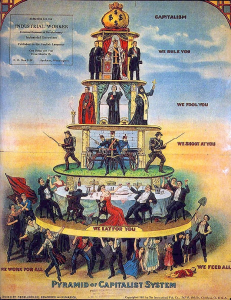8.1 Chapter Overview and Learning Objectives
8.1.1 Learning Objectives
- Differentiate between stratification systems.
- Apply classic and contemporary theories of stratification to the class structure of the United States.
- Describe the U.S. class structure.
- Describe several types of social mobility.
- Explain how class impacts people’s experiences in a variety of institutions.
- Explain how class impacts socialization processes.

Take a moment to think about the wealthy former president and chief executive officer (CEO) who is one of the largest landowners in the United States with a net worth estimated to be around $151 billion (Bloomberg’s Billionaire Index 2022, Brandt, Warran and Davis 2021). He used his wealth to buy Whole Foods and the Washington Post. Also, he founded a company that builds rocket ships. He then got to fly to space on one of those rocket ships. By some estimates, while he was CEO he made more than the median salary of a typical employee (around $28,000) every 10 seconds (Glum 2018).
In contrast, we have an employee in a warehouse in a job called a “picker” that involves gathering items to fulfill people’s online orders. One of the most productive workers in the warehouse, he was chosen to train others. Once he applied for a promotion but found the odds stacked against him; 382 people applied for the same position. The company intentionally made it hard to get ahead. As a result, he felt let down by his job where he did not get to share in the overall success in the company (Kantor, Weise, and Ashford 2021a).
You probably guessed that the first paragraph was about Jeff Bezos, the founder of Amazon. The second is about Derrick Palmer, an Amazon warehouse employee at the JFK8 Warehouse in New York. How can we use our sociological imagination to explain the vast disparities in wealth? Does wealth always connect to access to other valuable resources? How crucial is the distinction between employee and owner for the accumulation of resources? Can you work hard and still not get ahead? These are questions about social stratification, inequality, and social class, the focus of this chapter.
8.1.2 Licenses and Attributions for Overview
Figure 8.1. Pyramid of Capitalist System. Public Domain, via Wikimedia Commons.
“Overview” by Matthew Gougherty is licensed under CC BY 4.0.
